
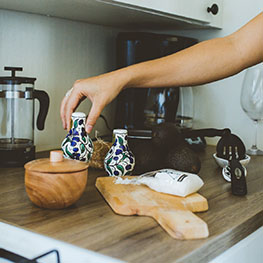
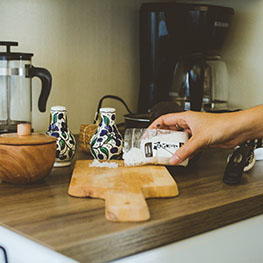
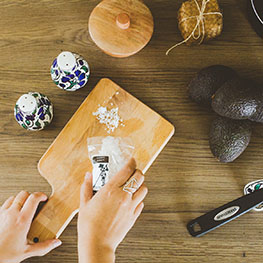
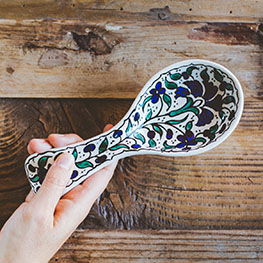

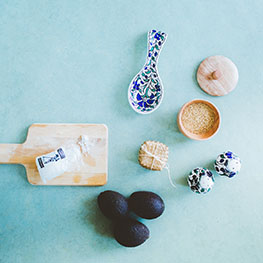
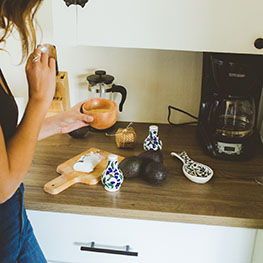
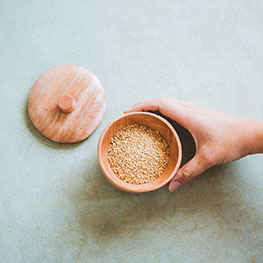

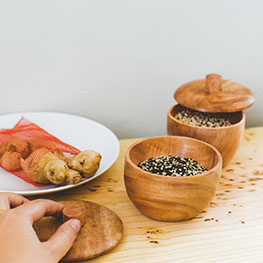
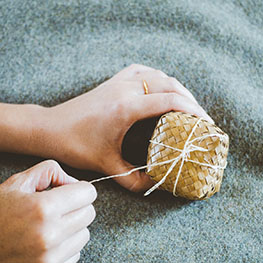
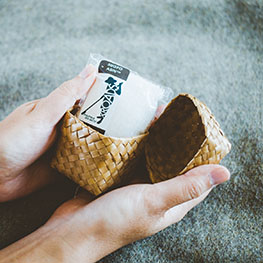



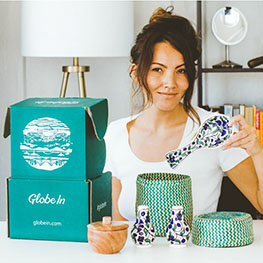


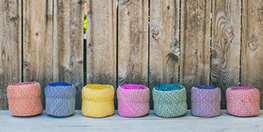
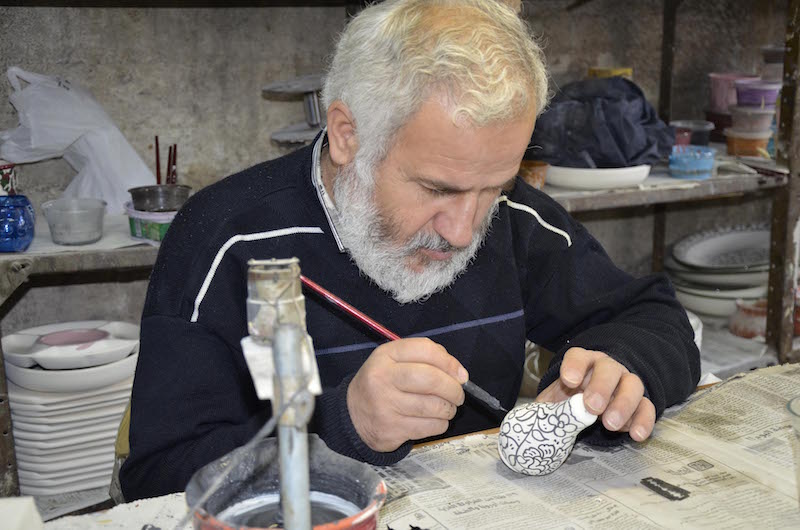
Salt and pepper add flavor to your food—your new hand-painted ceramic shakers are here to add flavor to your table. Their ornate floral design is an aesthetic staple of Palestinian heritage, curlicuing its way through mosques, homes, clothing—and many thousands of years.
Abd Jabari is a painter with Hebron Glass, a family company of glass and ceramic handicraft employing 60 artisans in the ancient city of Hebron. Lying on a pilgrimage route connecting Jerusalem to Makkah, Hebron has since ancient times been both a commercial hub and a city of great religious importance for Jews, Muslims, and Christians.
Tucked into a poor quarter of this oldest of cities, Abd paints the antique floral pattern onto ceramic shapes, making a living in this quiet, most ancient of ways. He sees his art as a way of painting Palestinian culture into the future.
Suggested use: Keep on the table for daily use, or reserve for holiday and party settings.

The land surrounding the ancient city of Hebron is rich with sand and clay, making it no wonder that glassware and ceramics are such prevalent handicrafts of the region.
Hebron is one of the oldest inhabited cities in the world, with archeological finds dating back some 5,000 years. Shards of ancient pottery may even bear floral patterns similar to the classic Palestinian design curling delicately across your new spoon rest.
Nour Diba, whose skillful painter’s hand deftly tends to the design’s fine eddies and curves, is an employee of Hebron Glass, a family company of glass and ceramic handicraft employing 60 artisans.
Suggested use: Situate on your stove or countertop for a splash of Middle Eastern flare and save those surfaces from drippy spoons you’re not quite ready to toss in the sink just yet.
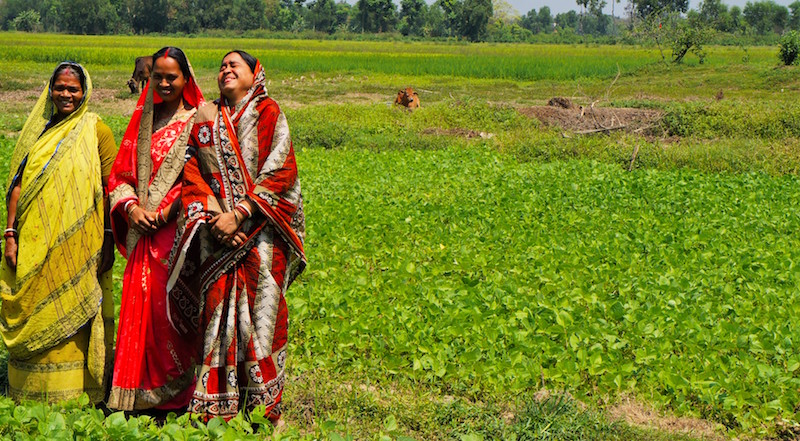
Your new spice bowl hails from India, heart of the ancient spice trade, famous for those exotic fires—ginger, cinnamon, and turmeric. These days, The Village Experience seeks to tap into contemporary avenues of international trade as a means of uplifting impoverished communities and especially women in the developing world.
Rabindranath and his wife Nila are two artisans at the helm of the West Bengal woodcarving community that fashioned your new bowl. Situated in a low-lying delta, this largely agricultural region has been hit hard by climate change. Traditional woodworking skills have become more important than ever in supplying vital income. By working with The Village Experience, and specifically as a result of GlobeIn’s large order, this community has seen a 23% increase in revenue over the past year.
Suggested use: Fill with your favorite spice, a meal-specific spice, or after-dinner mints!
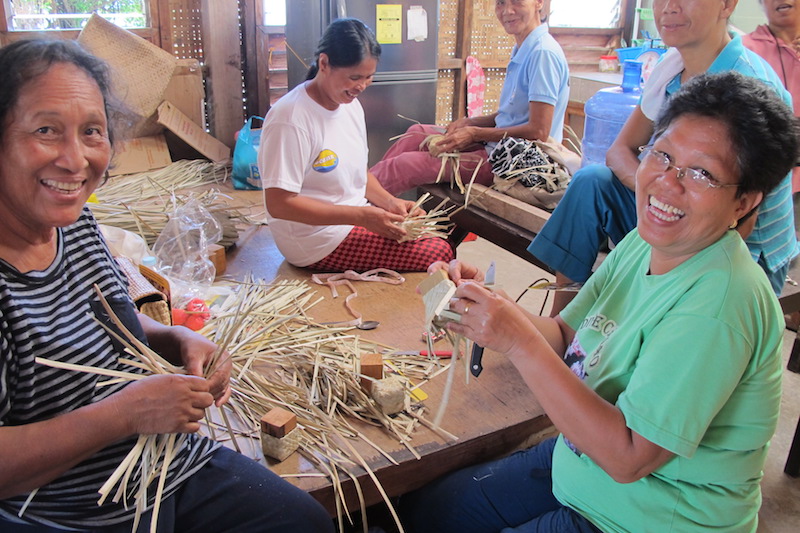
Just a dash of salt, and suddenly your food has so much more to say! A vital mineral for the body, salt adds the exclamation point to any dish, emphasizing every nuance of flavor.
Yet, as founder of roads Philippine Sea Salts points out, not all salt is created equal. Known as Ilocano Asin, your new sea salt was harvested from the pure seawaters off the island of Luzon by traditional salt farmers, or asinderos. Unlike highly processed generic table salts, the hollow crystals of this hand-crafted product offer a crunchy texture, while their flakiness melts bright mineral wealth crisp to the tongue into food.
Leaves of the romblon plant, woven by a network of women weavers on the tiny island of Cabilao, form the durable and eco-friendly box housing your new asin.
Suggested use: Whether savory or sweet, give your food a boost—use for grilling, roasting, and finishing.

Introducing Doña Filomena. Doña Filomena is one of fifteen basket weavers working for Doña Selerina in the remote town of San Luis Amatlán, Oaxaca, where marginalized indigenous groups struggle to keep their old ways of life alive.
Filomena’s husband died many years ago, and she raised their four children as a single parent. With the children now married off, Filomena lives alone, taking care of her chickens and goats. Working with GlobeIn has allowed Filomena to provide food and medicine for herself, as well as the opportunity to emerge from her empty nest and be part of a project with the other weavers.
Together, the women gather palm leaves from the hills. They dry the palms in the sun and paint them. With a dexterity passed down through generations, tireless fingers bring ancestry to life. The women weave the palms into vibrant, multi-colored baskets.
Suggested use: Employ as a container for bulk spices, teas, or cereals.